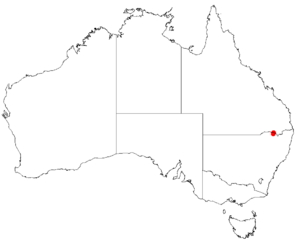Homoranthus bebo facts for kids
Quick facts for kids Homoranthus bebo |
|
|---|---|
 |
|
| Conservation status | |
| Scientific classification | |
| Genus: |
Homoranthus
|
| Species: |
bebo
|
 |
|
| Occurrence data from AVH | |
Homoranthus bebo is a special plant from the Myrtaceae family, which also includes gum trees! It only grows in a small area in northern New South Wales, Australia. This plant is a low-lying shrub, meaning it stays close to the ground. It has flat leaves and beautiful groups of up to ten yellow flowers. You can only find it in the Dthinna Dthinnawan Nature Reserve, close to a town called Yetman.
Contents
What Does Homoranthus bebo Look Like?
This amazing plant is a small shrub. It usually grows to be about 0.05–0.2 m (2–8 in) tall and can spread out 0.5–2 m (20–80 in) wide. Its branches often lie close to the ground.
The leaves of Homoranthus bebo are a bright, shiny lime-green color. They are shaped a bit like a narrow egg and are about 3–7 mm (0.1–0.3 in) long. They feel smooth and grow in pairs along the stem, each with a tiny point at the tip.
The flowers are a lovely lemon yellow and have five petals. They stand upright where the leaves meet the stem. You can usually see these flowers blooming in spring, mostly in September and October. Sometimes, you might even spot them as late as November!
How Homoranthus bebo Got Its Name
Naming the Plant
The plant Homoranthus bebo was officially described in 2011. This means scientists gave it its formal name. The scientists who first described it were Lachlan Copeland, Lyndley Craven, and Jeremy Bruhl.
They published their description in a science journal called Australian Systematic Botany. The name bebo comes from the Bebo State Forest. This is where the first example of the plant (called a type specimen) was collected in 2001. That forest is now known as the Dthinna Dthinnawan Nature Reserve.
Where Homoranthus bebo Lives
Habitat and Location
Homoranthus bebo is currently only found in one place. This special spot is the Dthinna Dthinnawan Nature Reserve. This reserve used to be called Bebo State Forest. It's located about 20 kilometers (about 12 miles) north-north east of Yetman in New South Wales.
These plants like to grow in deep, sandy soils. This type of soil is usually found over sandstone rock.
Why Homoranthus bebo Needs Protection
Conservation Status
This plant is very rare and special. Because of this, it has been listed as "critically endangered" under the Australian Government's EPBC Act of 1999. This means it's at a very high risk of disappearing forever.
Scientists know of only one group of these plants. This single group has at least 300 individual plants. Protecting this small population is very important to make sure Homoranthus bebo continues to survive.
Images for kids



